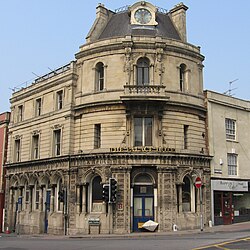| Old Market | |
|---|---|
 Palace Hotel, West Street | |
| General information | |
| Location | Bristol, England |
| Coordinates | 51°27′22″N 2°34′52″W / 51.456°N 2.581°W |
| OS grid | ST596732 |
Old Market is a Conservation Area of national significance, to the east of the city centre in Bristol, England.[1] Old Market Street and West Street form the central axis of the area, which is approximately bounded by New Street and Lawfords Gate to the north, Trinity Road and Trinity Street to the east, Unity Street and Waterloo Road to the south and Temple Way Underpass to the west.
Old Market Street is an ancient market place which developed immediately outside the walls of Bristol Castle on what was for many centuries the main road to London (now the A420); on market days Jacob Street and Redcross Street, which run parallel to Old Market Street, took the through traffic.[2] Old Market's Pie Poudre Court, which dealt out summary justice to market-day offenders, was not formally abolished until 1971.
The area contains some of Bristol's most ancient buildings, including the last two remaining houses jettied over the pavement and over sixty listed buildings.[1] Old Market suffered decades of neglect and severe decline in the mid-20th century due to the removal of Bristol's historic central shopping area from Castle Street to Broadmead and the construction of Temple Way Underpass and Easton Way, which severed it from Bristol's pre-war shopping axis in both directions.[1][3] Some important buildings still suffer from neglect, but the actions of local conservationists together with grant-aided schemes in the wake of its declaration as a Conservation Area in 1979 have done much to arrest the decline.
Old Market has in recent years become a centre of Bristol's gay scene, and has been proclaimed as ‘Bristol’s Gay Village’.[4]
- ^ a b c Conservation area 16 – Old Market – Character appraisal (PDF). Bristol City Council (Report). July 2008. Retrieved 3 March 2011.
- ^ Brown, Dorothy (1974). Bristol and how it grew. Bristol: Bristol Visual & Environmental Group, with the help of a grant from the South West Arts Association. p. 19. ISBN 0-9504648-2-1.
- ^ Priest, Gordon; Cobb, Pamela (1980). "Urban renewal". The Fight for Bristol. Bristol Civic Society and The Redcliffe Press.
- ^ "Gay districts and nightlife". VisitBristol. Retrieved 3 June 2011.

